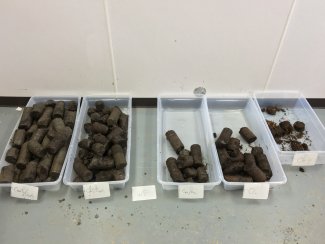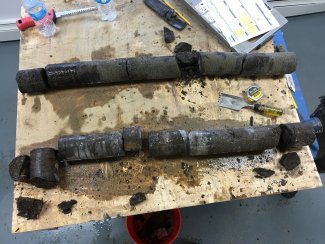Utqiaġvik NEON (BARR) Soil Descriptions
Distributed Soils Reports
Pedon Descriptions
Pit‐level observations and field measurements reported using the standard NRCS format. They contain volume estimates for coarse fragments > 20 mm where applicable.
Site Level Plot Summary
A narrative summary that places the sampled soil pedons in the broader context of soils and geomorphology for the entire NEON site.
Megapit Images

D18 BARR megapit soil profile 0-180 cm

D18 BARR megapit soil profile
Megapit Pedon Description
| Print Date | Feb 21 2018 |
|---|---|
| Description Date | Apr 1 2016 |
| Site ID | S2016AK185002 |
| Pedon ID | S2016AK185002 |
| Lab Source ID | KSSL |
| Lab Pedon # | 16N1524 |
| Geomorphic Setting | None Assigned |
| Description origin | NASIS |
| County | North Slope Borough |
| MLRA | 246 -- Arctic Coastal Plain |
| Std Latitude | 71.2817100 |
| Std Longitude | -156.6502000 |
| Description database | KSSL |
| Elevation (meters) | 7.0 |
| Horizon Details |
Oe--0 to 7 centimeters (0.0 to 2.8 inches); black (7.5YR 2.5/1) broken face mucky peat; noneffervescent; moderately acid, pH 5.7, pH meter. Lab sample # 16N06969 Oa--7 to 32 centimeters (2.8 to 12.6 inches); 50 percent black (7.5YR 2.5/1) broken face and 50 percent very dark brown (7.5YR 2.5/2) broken face peat; noneffervescent; moderately acid, pH 5.6, pH meter. Lab sample # 16N06970 Cgjj/Oajj--32 to 45 centimeters (12.6 to 17.7 inches); 75 percent very dark grayish brown (2.5Y 3/2) broken face and 25 percent very dark brown (7.5YR 2.5/2) broken face peat, silt loam; noneffervescent; slightly acid, pH 6.1, pH meter. Lab sample # 16N06971 Wf--45 to 58 centimeters (17.7 to 22.8 inches); water. Oaf/Cgjjf--58 to 110 centimeters (22.8 to 43.3 inches); 40 percent very dark grayish brown (2.5Y 3/2) broken face and 30 percent black (10YR 2/1) broken face and 30 percent very dark brown (10YR 2/2) broken face peat, silt loam; 25 percent clay; noneffervescent; moderately acid, pH 5.9, pH meter. Lab sample # 16N06972 Cgjff/Oajjf--110 to 180 centimeters (43.3 to 70.9 inches); 55 percent dark gray (2.5Y 4/1) broken face and 25 percent black (10YR 2/1) broken face and 20 percent dark grayish brown (2.5Y 4/2) broken face peat, silt loam; 15 percent clay; noneffervescent; neutral, pH 6.8, pH meter. Lab sample # 16N06973 |
Credits: This megapit soil pedon description was generously created by USDA Natural Resource Conservation Service staff, with particular thanks to Larry West, Jon Hempel, and numerous field staff.